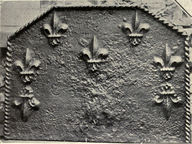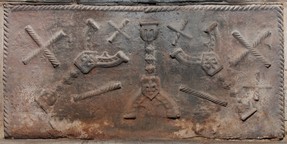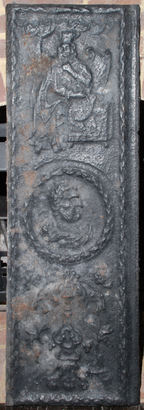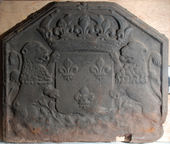-
318
Description: Canted rectangle; twisted rope edging (top and sides); symmetrical arrangement of a fleur-d-lys stamp repeated seven times (2-3-2), with the middle one of the three slight above the other two, and the bottom two inverted immediately below the outer two of the three.
Notes: The style of the fleurs is identical to those on two firebacks decorated with firedogs bearing the initials, HN, and the crossed staple badge of the Nevills; Henry Nevill occupied Mayfield furnace from about 1585 until 1599.
- Decoration tags:
- rectangular with canted top corners (shape)
- rope (edging)
- carved stamps
- heraldic
Manufactured: in the late-16th century possibly at Mayfield Furnace in the Weald area of England.
Current location: not known.
Citation: Hayden, A., 1912, Chats on Cottage and Farmhouse Furniture (Unwin, London).
- Attached to series:
- Henry Nevill series
-
1127
Description: Plain rectangle; no edging; top centre, date between two six-pointed stars.
Notes: Characteristic of the last firebacks cast at Ashburnham Furnace, Sussex. One of a small series of firebacks cast in the early-19th century for farms on the Ashburnham estate.
Inscription: * 1812 *
- Decoration tags:
- rectangular (shape)
- none (edging)
- carved stamps
- individual numbers
- text
- objects
Manufactured: in 1812 at Ashburnham Furnace in the Weald area of England.
Current location: not known.
- Attached to series:
- Date only firebacks
- Ashburnham late series
-
912
Description: Rectangular; twisted rope edging (top and sides); impression of the end of a firedog repeated three times, one upright in centre, two diagonally inverted with feet angled towards top centre; a large saltire of twisted rope in each top corner, a small saltire, of twisted rope and dowel, on either side of top of central firedog; cross of twisted rope below right hand corner saltire; lower centre, two angled rope lengths either side of central firedog. At the bottom, and outside the feet of the central firedog, two excrescences formed by the pouring of the metal.
Notes: A well-preserved example with an unusual arrangement of the firedog stamp; formerly (c.1886) in the Warbill-in-Tun inn, Warbleton, Sussex.
- Decoration tags:
- rectangular (shape)
- rope (edging)
- simple stamps
- apotropaic
- objects
Manufactured: in the mid- to late-16th century in the Weald area of England.
Current location: in private hands, Heathfield, East Sussex, England.
Citation: Balcomb, J. T., Nov. 1886, 'An Extinct Sussex Art', The Art Journal, pp. 337-340.
- Attached to series:
- Firedog stamp firebacks
- Metalware stamp firebacks
-
921
Description: Canted rectangle; twisted rope edging (top and sides); central arrow-shaped design formed of three repeated rope lengths.
Notes: The arrow design probably has an apotropaic (evil-averting) purpose, perhaps intended as the initials VV for 'virgo virginum'.
- Decoration tags:
- rectangular with canted top corners (shape)
- rope (edging)
- simple stamps
- apotropaic
- objects
Manufactured: in the 16th century in the Weald area of England.
Current location: in private hands, Heathfield, East Sussex, England.
- Attached to series:
- Rope design firebacks
-
922
Description: Rectangular; no edging; arrangement of eight fleur de lys stamps formed of, at top centre, four in a cross shape, with two in line on each side; on each side of the cross arrangement is a naked standing putto stamp.
Notes: The putti are an unusual addition to what is a quite crudely decorated fireback
- Decoration tags:
- rectangular (shape)
- none (edging)
- carved stamps
- heraldic
- humans
Manufactured: in the late-16th century in the Weald area of England.
Current location: in private hands, Heathfield, East Sussex, England.
- Attached to series:
- Figurine firebacks
-
923
Description: Rectangular; overlapping laurel leaf edging with flange on right edge; top, seated figure of a monarch with a casket at his left side and the back of a throne behind; centre, bust of a classical male figure facing to the right, surrounded by a circlet of overlapping laurel leaves; bottom, ornamental pedestal on a legged stand, floral fronds issuing from the top, between two flower heads, and descending symmetrically to the bottom.
Notes: Not a fireback, but a left side fireplace back plate. It had a circular aperture in the centre into which, in this instance, a medallion and bust were inserted, the same being inserted into an elaborate baroque fireback (no. 452).
- Decoration tags:
- rectangular (shape)
- overlapping laurel leaf (edging)
- carved stamps
- carved pattern panels
- biblical
- humans
- plants
Manufactured: in the early- to mid-18th century probably at Robertsbridge Furnace, Salehurst in the Weald area of England.
Current location: in private hands, Heathfield, East Sussex, England.
- Attached to series:
- Baroque series
- Fireplace back plates
-
191
Description: Arched rectangle; cavetto moulded edging; Tudor royal shield, Garter and crown, with crowned lion and dragon supporters; motto along bottom; Tudor rose to left of crown, portcullis to right.
Notes: This painted fireback is reputed to have been a gift from King Henry VIII to the second Sir William Godolphin, who was present at the Siege of Boulogne in 1544 with a party of Godolphin tin miners. Copies of this style of fireback were advertised in Kings Worthy Foundry's (Winchester) catalogue in the mid-20th century.
Copies of this fireback are known.
Inscription: HONI SOIT QVI MAL E PENSE / DIEU ET MON DROIT
Arms: Tudor royal (Elizabeth I)
- Decoration tags:
- rectangular with round arch (shape)
- cavetto (edging)
- whole carved pattern
- armorial
- text
Manufactured: in the mid- to late-16th century possibly in the Weald area of England.
Current location: Godolphin House, Helston, Cornwall, England.
Museum number: 169480 (part of the National Trust museum group)
- Attached to series:
- Tudor royal armorial firebacks
-
192
Description: Rectangular; twisted rope edging (top and sides); irregular arrangement of four stamps in three rows: face mask with ?crown and ruff (3), flower head with four petals and leaflets (4), fleur de lys (5), and profile of a head with 'Roman' crest (2); initials replace stamps in top corners.
Notes: A larger variant, undated and with other initials but the same four stamps, is also known.
Inscription: TBI I•A•1•6•1•8 / TA S
- Decoration tags:
- rectangular (shape)
- rope (edging)
- carved stamps
- individual letters
- individual numbers
- heraldic
- text
- humans
- plants
Manufactured: in 1618 possibly in the Weald area of England.
Current location: Godolphin House, Helston, Cornwall, England.
Museum number: 169481 (part of the National Trust museum group)
- Attached to series:
- Primitive stamp series
-
938
Description: Rectangular with three-facetted arch; fillet edging; shield, crown and lion supporters of the French royal house of Valois.
Notes: The arms date to before 1589 when the House of Valois was succeeded by the House of Bourbon. Lion supporters on the French royal arms are not common.
Arms: France Royal
- Decoration tags:
- rectangular with three-facetted arch (shape)
- fillet (edging)
- whole carved pattern
- planklines
- armorial
Manufactured: in the late-16th century in France.
Current location: not known.
- Attached to series:
- Foreign armorial firebacks
-
939
Description: Rectangular with triangular top; ovolo-moulded edging; shield and crown of the French royal house of Valois, encircled by the collars of the orders of Saint Michel and Saint-Esprit
Notes: Cast no later than 1589 when the House of Valois was succeeded by the House of Bourbon.
Arms: France Royal
- Decoration tags:
- triangular arched (shape)
- ovolo (edging)
- whole carved pattern
- planklines
- armorial
Manufactured: in the late-16th century in France.
Current location: not known.
- Attached to series:
- Foreign armorial firebacks









